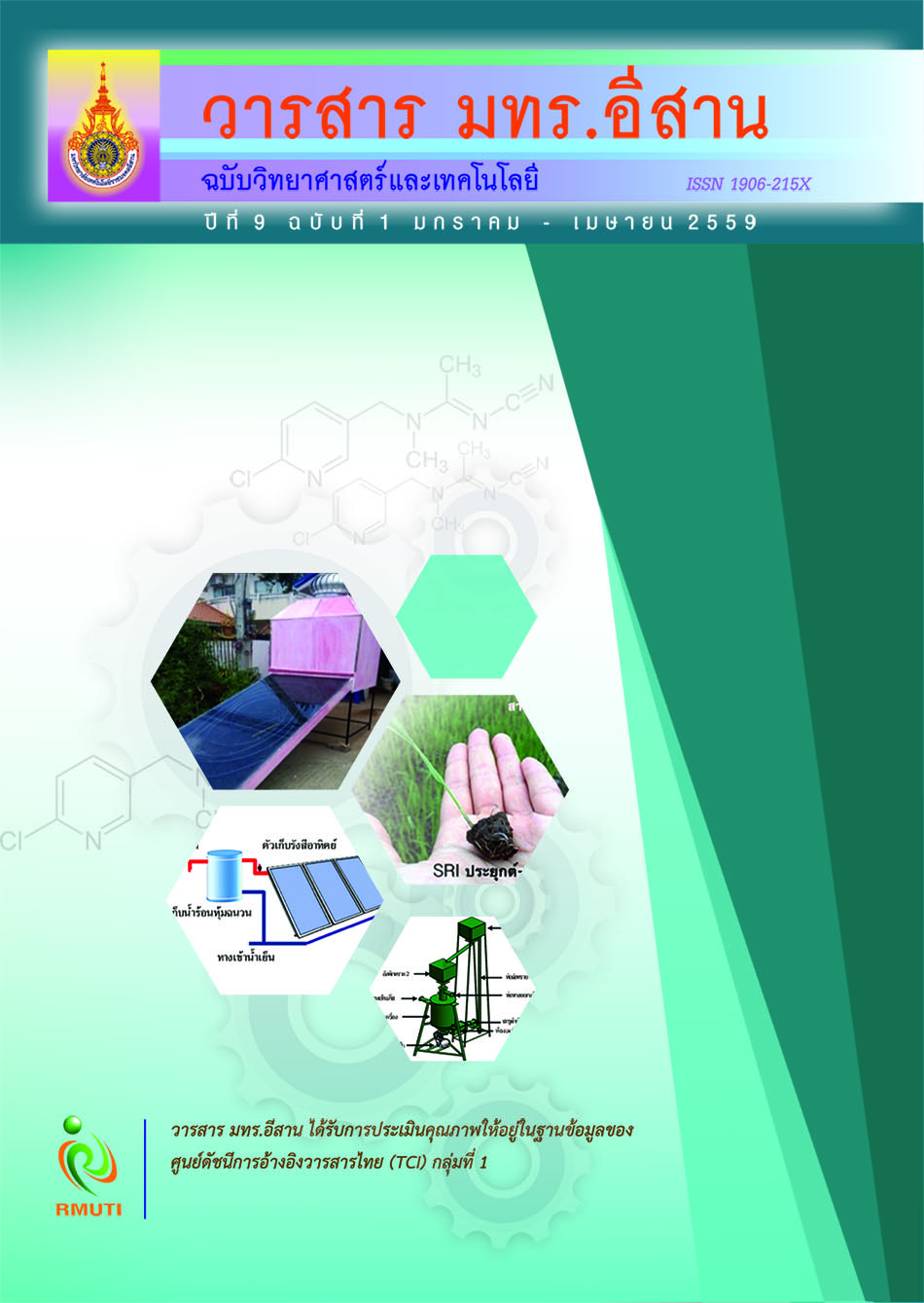การปรับปรุงฝุ่นข้าวโพดด้วยเอนไซม์เพื่อใช้เป็นพรีไบโอติกในอาหารสัตว์ (Improvement of Pre-treating Corn Dust with Enzyme as Prebiotics in Animal Feed)
Main Article Content
Abstract
บทคัดย่อ
การศึกษาในครั้งนี้มีวัตถุประสงค์เพื่อปรับปรุงฝุ่นข้าวโพดด้วยเอนไซม์เพื่อใช้เป็นพรีไบโอติกในอาหารสัตว์
จากการศึกษาในครั้งนี้พบว่า ฝุ่นข้าวโพดที่ถูกย่อยด้วยเอนไซม์เซลลูเลส (ACCELLERASE 1000,
Sigma-Aldrich) ที่ระดับร้อยละ 0.8 มีองค์ประกอบทางเคมี คือ ปริมาณเยื่อใยหยาบร้อยละ 22.09
ปริมาณเถ้าร้อยละ 1.57 วัตถุแห้งร้อยละ 24.36 ความชื้นร้อยละ 75.64 มีความแตกต่างจากฝุ่นข้าวโพด
ที่ถูกย่อยด้วยเอนไซม์ที่ระดับอื่นอย่างมีนัยสำคัญทางสถิติ (P<0.05) และพบว่าปริมาณนํ้าตาลรีดิวซ์เพิ่มขึ้น
เป็น 6.15 มก./มล. หลังจากนั้นนำมาทำการทดสอบโอลิโกแซคคาไรด์ซึ่งพบว่าเอนไซม์ทุกระดับสามารถย่อย
ให้ได้ผลิตภัณฑ์เป็นนํ้าตาลราฟฟิโนส และการทดสอบคุณสมบัติความเป็นพรีไบโอติก (ที่ระดับความเข้มข้น
0.15 0.30 0.45 0.60 และ 0.70 มก./มล.) สามารถส่งเสริมการเจริญเติบโตของเชื้อ Lactobacillus
acidophilus ได้ทุกระดับความเข้มข้น โดยที่ระดับความเข้มข้น 0.60 มก./มล. มีอัตราการเจริญเติบโต
สูงกว่าการทดลองอื่น ๆ อย่างมีนัยสำคัญทางสถิติ (P<0.05) และมีความสามารถยับยั้งการเจริญเติบโต
ของเชื้อ Escherichia coli ที่ระดับความเข้มข้น 0.70 มก./มล. สูงกว่าการทดลองอื่น ๆ อย่างมีนัยสำคัญ
ทางสถิติ (P<0.05)
Abstract
The objective of this study is to improve pre-treating corn dust with enzymes as
prebiotics in animal feed. This study found that corn dust digested by cellulase enzyme
(ACCELLERASE 1000, Sigma Aldrich) that are at a concentration of 0.8 percent resulted
in the following reductions of the composition; crude fiber to 22.09 percent, ash content
to 1.57 percent, dry matter to 24.36 percent, and moisture to 75.64 percent. Differing
enzyme levels were statistically significant (P<0.05). Reducing sugar increased to
6.15 mg/ml. The oligosaccharides test found that the enzyme could digest at all
levels, ensuring that product is Raffinose sugar. The experiment to examine prebiotics
property (on of the concentration of 0.15 0.30 0.45 0.60 and 0.70 mg/ml), a concentration
of 0.60 mg/ml produced the optimum growth rate of Lactobacillus acidophilus was
statistically significant (P<0.05), whereas a concentration of 0.70 mg/ml was the optimum
level to inhibit the growth of Escherichia coli and was statistically significant (P<0.05).
Article Details
References
Washington, D.C. U.S.A
Lawal, T. E., Iyayi, E. A., Adeniyi, B. A., and Adaramoye O. A. (2010). Biodegradation of
palm kernel cake with multienzyme complexes from fungi and its feeding value
for broilers. International Journal of Poultry Science. Vol. 9. Number 7. pp. 695-701
Miller, G. L. (1959). Use of dinitrosalicylic acid reagent for determination of reducing
sugar. Analytical Chemistry. Vol. 31. No. 3. pp. 426-428
Ng, W. K., Lim, H. A., Lim, S. L. and Ibrahim, C. O. (2002). Nutritive value of palm kernel
meal pretreated with enzyme or fermented with Trichoderma konningii
(Oudemans) as a dietary ingredient for red hybrid tilapia (Oreochromis sp.).
Aquaculture Research. Vol. 33. Issue 15. pp. 1199-1207
Nipat, L. (2004). The extraction process antimicrobial properties of a substance and
antioxidants from green tea catechins of Thailand. Bachelor of Science Thesis
Silpakorn University, Nakornpatom
Pichamon, D., Sudathip, J. and Sunee, N. (2013). The influence of the type and quantity of
agricultural wastes to produce oligomer Sachs polysaccharide solution with an
enzyme extract from Penicllium oxalicum KUB-SN2-1. KMUTT Research and
Development Journal. Vol. 36. Number 1. pp. 73-84
Pornpan, S. and Suphawadee, C. (2012). Improvement of pre-treating spent tea leaves
with enzyme as prebiotics for animal feed. Faculty of Animal Science and
Agricultural Technology. Silpakorn University Phetchaburi IT Campus
Sukon, T., Tienchai, N. and Petchradaa, D. (2012). Antibacterial activity of the extract
from the bark of certain fruits. KKU Research Journal. Vol. 17. Issue 6. pp. 880-894
Taweesak, S., Srisamai, W., Churee, P. and Suwanna, T. (2008). Efficacy in reducing
bacteria extracts from tea waste, the series of “herbs in animal tests”. Thailand
Research Fund (TRF) Faculty of Veterinary Science Kasetsart University, Bangkok
Thanawan, S., Jakkrit, T., Kin, L. K. and Kanok, R. (2008). Products from the fermentation
of Bacillus sp. strain TW-1 in a corn husk carbon source under conditions where
oxygen is limited. KMUTT Research and Development Journal. Vol. 31.
Number 2. pp. 291-304


